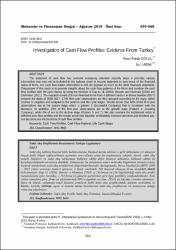Investigation of Cash Flow Profiles: Evidence From Turkey
Citation
Güleç, Ö.F. & Işıl, E. (2017). Denetim Kalitesinin Kazanç Yönetimi Uygulamaları Üzerindeki Etkisi: BİST Şirketleri Üzerine Bir Araştırma. 2. Uluslararası Trakya Muhasebe Finans ve Denetim SempozyumuAbstract
The statement of cash flow has received increasing attention recently since it provides various information that may not be included in the balance sheet or income statement to keep track of the financial status of firms. Yet, cash flow-based information is still not popular as much as the other financial statements. Thepurpose of this study is to provide insights about the cash flow patterns of the firms and combine the cash flow profiles with life cycle theory by using the methods of Gup et. al. (1993), Bruwer and Hamman (2005) and Dickinson (2011). The research covers 206 non-financial firms from 4 different sectors in Borsa Istanbul (BIST) between the dates of 2008-2017. 1.793 firm-year observations are first grouped according to the signs, either positive or negative and assigned to the patterns and life cycle stages. Results reveal that 40% of the firm-year observations are at the mature stage which is pattern 2 (Successful Company) that is consistent with the literature. In addition, 23% of the firm-year observations are at the growth stage (Pattern 4, Growing Company), while 6% of are at the decline stage (Pattern 5 and 7). We also examine the traditional ratios in different cash flow profiles and the results prove that liquidity, profitability financial structure and dividend pay- out decisions are the functions of cash flow profiles. Nakit akış tablosu finansal tablo kullanıcılarına, finansal durum tablosu ve gelir tablosunda yer almayan birçok farklı bilgiyi sağlayabilmesi açısından son yıllarda artan bir popülariteye sahiptir. Ancak, nakit akış temelli bilgilerin ve nakit akış tablosunun kullanım sıklığı diğer finansal tabloların kullanım sıklığı ile karşılaştırıldığında son derece düşüktür. Dolayısıyla, bu çalışmanın amacı nakit akış bilgilerinin önemini ortaya koyarak işletmelerde nakit akış profillerinin değerlendirilmesidir. Bu kapsamda, Borsa İstanbul’da (BİST) 2008 – 2017 yılları arasında faaliyet gösteren 4 farklı sektördeki 206 finansal olmayan firma örneklem olarak belirlenmiştir. Gup vd. (1993), Bruwer ve Hamman (2005) ve Dickinson’un (2011)geliştirdiği nakit akış profili metodolojisine göre öncelikle, 1.793 firma-yıl gözlemi işaretlerine göre ilgili profillere sınıflandırılmıştır. Elde edilen sonuçlara göre, firma yıl gözlemlerinin 40%’ı olgunluk evresine, 23%’ü ise büyüme evresine atanmıştır. Buna ek olarak, çalışmada temel finansal oranların farklı nakit akış profillerindeki durumu incelenmiş ve likidite, kârlılık, sermaye yapısı ve temettü ödeme kararlarının nakit akış profillerinin bir fonksiyonu olduğu sonucuna ulaşılmıştır.
Source
Muhasebe ve Finansman DergisiCollections
- Makale Koleksiyonu [443]
- TR-Dizin İndeksli Yayınlar Koleksiyonu [1037]



















